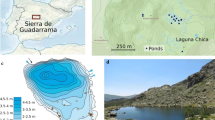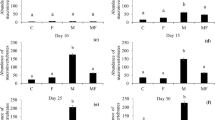Abstract
In the last decennia eutrophication has caused a shift in the species composition of fish communities in Dutch fresh waters. The changes have led to the disappearance of vegetation in lakes and ponds; zooplankton and chironomids are now the most abundant food organisms for fish. In the turbid, open waters bream and pikeperch are the dominant fish species. Only small bream is vulnerable to predation, but because bream grows much faster than the other cyprinids the time span in which the fish is vulnerable is the shortest. The large bream (>20 cm) can coexist with pikeperch since it is not vulnerable to predation and still utilizes the food organisms efficiently. Eutrophication is accelerated if both bream populations are composed of small-sized specimens preventing large-sized zooplankton to develop, and if they are composed of large-sized individuals which can efficiently stir up the bottom sediments.
Similar content being viewed by others
References
ANDERSSON, G., H. BERGGREN, G. CRONBERG and C. GELIN, 1978. Effect of planktivorous and benthivorous fish on organisms and water chemistry in eutrophic lakes. Hydrobiologia, 59: 9–15.
BEATTIE, M., 1982. Distribution and production of the larval chironomids populations in Tjeukemeer. Hydrobiologia, 95: 287–306.
BNINSKA, M., 1985. The possibilities of improving catchable fish stocks in lakes undergoing eutrophication. J. Fish Biol., 27: 253–261.
BRABRAND, A., B. FAAFENG and J.P.M. NILSSEN, 1986. Juvenile fish and invertebrate predators: delaying the recovery phase of eutrophic lakes by suppression of efficient filter feeders. J. Fish Biol., 29: 99–107.
BRENNER, R.W., J.R. STRICKLER and W.J. O'BRIEN, 1978. Capture probability: the role of zooplankter escape in the selective feeding of planktivorous fish. J. Fish. Res. Board Can., 35: 1370–1373.
GRIMM, M.P., 1989. Northern pike (Esox lucius L.) and aquatic vegetation, tools in the management of fisheries and water quality in shallow waters. Hydrobiol. Bull., 23: 59–65.
HARTLEY, P.H.T., 1947. The natural history of some British freshwater fishes. Proc. Zool. Soc. Lond., 117: 129–206.
HARTMANN, J., 1977. Fischereiliche Veränderungen in kulturbedingt eutrophierenden Seen. Schweiz. Z. Hydrol., 39: 243–253.
HOLCIK, J., 1977. Changes in fish community of Klicava reservoir with particular reference to Eurasian perch (Perca fluviatilis), 1957–72. J. Fish Res. Board Can., 34: 1734–1747.
HOSPER, S.H., M.-L. MEIJER and E. JAGTMAN, 1987. De mogelijkheden van actief biologisch beheer bij het herstel van onze meren en plassen. H2O, 1987: 274–279.
LAMMENS, E.H.R.R., 1984. A comparison between the feeding of white bream (Blicca bjoerkna) and bream (Abramis brama). Verh. Internat. Verein. Limnol., 22: 886–890.
LAMMENS, E.H.R.R., 1985. A test of a model for planktivorous filter feeding by bream (Abramis brama). Envir. Biol. Fish., 13: 288–296.
LAMMENS, E.H.R.R., 1986. Interactions between fishes and the structure of fish communities in Dutch shallow eutrophic lakes. Ph. D. Thesis. Agricultural University Wageningen, 100 pp.
LAMMENS, E.H.R.R., 1988. Trophic interactions in the shallow, eutrophic lake Tjeukemeer: bottom-up and top-down effects in relation to hydrology, bioturbation and predation during the period 1974–1985. Hydrobiologica, 19: 81–87.
LAMMENS, E.H.R.R., W.L.T. VAN DENSEN and J. VIJVERBERG, 1986. The role of predation in the community structure of fish and zooplankton in Dutch hypetrophic lakes, a comparative study. In: Interactions between fishes and the structure of fish communities in Dutch shallow eutrophic lakes. Ph. D. Thesis (Lammens). Agricultural University Wageningen.
LAMMENS, E.H.R.R., J. GEURSEN and P.J. McGILLAVRY, 1987. Diet shifts, feeding efficiency and coexistence of bream (Abramis brama), roach (Rutilus rutilus) and white bream (Blicca björkna) in eutrophicated lakes. Proc. V Congr. Europ. Ichtyol., Stockholm, p. 153–162.
LAMMENS, E.H.R.R., H.W. DE NIE, J. VIJVERBERG and W.L.T. VAN DENSEN, 1985. Resource partitioning and niche shifts of bream (Abramis brama) and eel (Anguilla anguilla) mediated by predation of smelt (Osmerus eperlanus) onDaphnia hyalina. Can. J. Fish. Aquat. Sci., 42: 1342–1351.
LASKAR, K., 1948. Die Ernährung des Brassens (Abramis brama) im eutrophen See. Arch. Hydrobiol. 42: 1–165.
MULLER, M., J.W.M. OSSE and J.H.G. VERHAGEN, 1982. A quantitative hydrodynamical model of suction feeding in fish. J. Theor. Biol., 95: 49–79.
PIVNICKA, K. and M. SVATORA, 1977. Factors affecting the shift in predominance from Eurasian perch (Perca fluviatilus) to roach (Rutilus rutilus) in the Klicava reservoir, Czechoslovakia. J. Fish. Res. Board Can., 34: 1571–1575.
POPOVA, O.A. and L.A. SYTINA, 1977. Food and feeding relations of Eurasian perch (Perca fluviatilus) and pikeperch (Stizostedion lucioperca) in various waters of the USSR. J. Fish. Res. Board Can., 34: 1559–1570.
PREJS, A., 1976. Fishes and their feeding habits. In: Problems of littoral lake ecology, Ed. E. Pieczinska. Warsaw, 238 pp.
RUNDBERG, H., 1977. Trends in harvest of pikeperch (Stizostedion lucioperca), Eurasian perch (Perca fluviatilus) and northern pike (Esox lucius) and associated environmental changes in lakes Malaren and Hjalmaren, 1914–74. J. Fish. Res. Board Can., 34: 1720–1724.
SIBBING, F.A., 1984. Pharyngeal mastication and food processing in carp. Ph. D. Thesis. Agricultural University Wageningen.
SVARDSON, G., 1976. Interspecific population dominance in fish communities of Scandinavian lakes. Rep. Inst. Freshwat. Res. Drottningholm, 56: 144–171.
TEN WINKEL, E.H., 1987. Chironomid larvae and their food web relation in the littoral zone of Lake Maarsseveen. Ph. D. Thesis. University of Amsterdam, 145 pp.
VAN DENSEN, W.L.T., 1985. Feeding behaviour of major 0+ fish species in a shallow, eutrophic lake (Tjeukemeer, The Netherlands). J. Appl. Ichthyol., 2: 49–70.
VAN DENSEN, W.L.T., and J. VIJVERBERG, 1982. The relations between 0+ fish density, zooplankton size and vulnerability of pikeperch,Stizostedion lucioperca, to angling in the Frisian lakes. Hydrobiologia, 95: 321–336.
VAN DENSEN, W.L.T., C. DIJKERS and R. VEERMAN, 1986. The fish community of the Loosdrecht Lakes and the perspective for biomanipulation. Hydrobiol. Bull., 20: 147–163.
VAN DONK, E., R.D. GULATI and M.P. GRIMM, 1989. Food web manipulation in lake Zwemlust: positive and negative effects during the first two years. Hydrobiol. Bull., 23: 19–34.
VIJVERBERG, J. and A.F. RICHTER, 1982a. Population dynamics and production ofDaphnia hyalina Leydig andDaphnia cucullata Sars in Tjeukemeer. Hydrobiologia 95: 235–259.
VIJVERBERG, J., and A.F. RICHTER, 1982b. Population dynamics and production ofAcanthocyclops robustus Sars andMesocyclops leuckartii Claus. Hydrobiologia, 95: 261–274.
WILLEMSEN, J., 1977. Population dynamics of percids in Lake IJssel and some smaller lakes in The Netherlands. J. Fish. Res. Board Can., 1710–1719.
WINFIELD, I.J., G. PEIRSON, M. CRYER and C.R. TOWNSEND, 1983. The behavioural basis of prey selection by underyearling bream (Abramis brama (L.)) and roach (Rutilus rutilus (L.)). Freshwater Biology, 13: 139–149.
WUNDSCH, H.H., 1949. Grundlagen der Fischhwirtschaft in den Grosstaubecken. Abh. Fisch. Hilfwiss., Lief 1: 17–186.
Author information
Authors and Affiliations
Rights and permissions
About this article
Cite this article
Lammens, E.H.R.R. Causes and consequences of the success of bream in Dutch eutrophic lakes. Hydrobiological Bulletin 23, 11–18 (1989). https://doi.org/10.1007/BF02286423
Issue Date:
DOI: https://doi.org/10.1007/BF02286423




